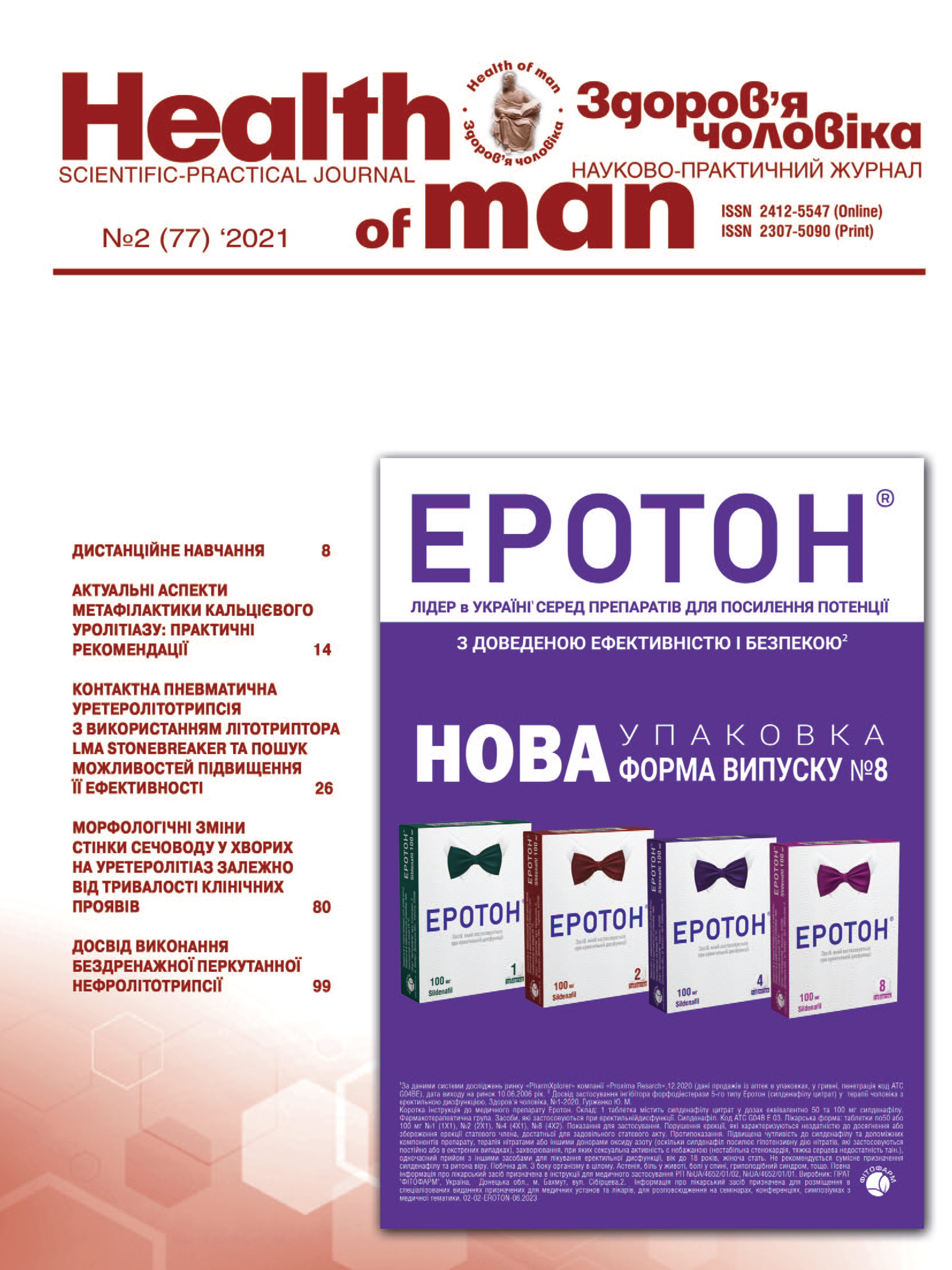Contact Pneumatic Ureterolithotripsy Using LMA StoneBreaker Lithotriptor and Search for Opportunities to Increase Effectiveness
##plugins.themes.bootstrap3.article.main##
Abstract
The objective: to evaluate the effectiveness of portable pneumatic contact lithotripter LMA StoneBreaker in endoscopic contact ureterolithotripsy of ureteral stones of different localization depending on their density and search for opportunities to increase it.
Materials and methods. Contact pneumatic ureterolithotripsy was performed in 89 patients (49 men, 40 women), 39 (43.8%) patients (I group) underwent standard contact pneumoureterolithotripsy, and 50 (56.2%) patients (11 group) – modified (with prior fixation of the stone in the ureter loop Dormia), which allowed urethrolithotripsy in situ and prevented the migration of stones and their fragments proximally.
The number of strokes required to initiate fragmentation, complete fragmentation, and total ureterolithotripcy time for stones of different localization and density were determined. The integrity of the stones was determined by computed tomography in units of Haunsfield (HU). The mineral composition of stone fragments after their removal was diagnosed by X-ray diffraction analysis. The effectiveness of the applied methods was evaluated in groups of patients by complete (100%) removal of stone fragments from the ureter and by the number of cases of retrograde migration of stones into the renal cavity.
Results. No intraoperative complications were observed. The number of strokes for the initial and complete disintegration of the stone, regardless of the method of ureterolithotripsy and their localization, depended on their density, ie its mineral composition. The minimum number of strokes for start and complete fragmentation of the stone was recorded in patients with a stone density of 480+54 HU and diagnosed as phosphates. Oxalate and uric acid stones, as well as their combinations (density 1310–1580 HU) required the maximum number of blows. Stone migration was noted in 8 (8.99%) patients. Thanks to intraoperative stone fixation was able to reduce the average time of lithotripsy (from 15,65±6.9 min to 12.3±6,15 min) and reduce the frequency of retrograde stone migration from 15.4% (in 6 patients of group 1) to 4% (2 patients of ІI group). The dependence of lithotripsy efficiency on stone localization is established. It was highest in patients with stones of the lower third of the ureter (95% in patients of group 1 and 100% of patients in group II) and with low density (480–840 HU). The lowest efficacy was observed in patients whose stones were localized in the upper third of the ureter (66.3% in group I and 90% in group II) and had a high density (more than 1200 HU). Due to the fixation of the stone with modified pneumoureterolithotripsy, the overall effectiveness of the method increased from 84.6% to 96%.
Conclusions. Traneurethral contact pneumoureterolithotrysis using a portable pneumatic lithotripter LMA Stonebreaker – is effective, safe, minimally costly and easy to use. The effectiveness of contact pneumatic ureterolithotripsy depends on the location and density of the stone. The number of strokes required for the initial and complete fragmentation of the stone directly depends on the density of the stone and does not depend on its location and method of performing pneumoureterolithotripsy.
The use of a modified technique with fixation of the stone in the ureter during the process of lithotripsy reduces the time of the operation and increases its effectiveness.
##plugins.themes.bootstrap3.article.details##

This work is licensed under a Creative Commons Attribution 4.0 International License.
Authors retain the copyright and grant the journal the first publication of original scientific articles under the Creative Commons Attribution 4.0 International License, which allows others to distribute work with acknowledgment of authorship and first publication in this journal.
References
Yedinyy YG. Electrohydraulic cystolithotripsy. Kyiv: Zdorov’ya; 1975.
Vozianov SO, Chernenko VV, Chernenko DV, Sokolenko ST. Contact pneumatic lithotripsy in the treatment of urolithiasis. Men’s Health. 2018;3:94–6.
Martov AG, Gordienko AY, Kornienko SI, Danelyan SS. Transurethral endoscopic treatment of large stones in the upper third of the ureter using the new pneumatic lithotripter LMA Stone-Breaker. Kuban Scientific Medical Bulletin. 2011;5:94–5.
Akilov FA, Giyasov SI, Mukhtarov ST, Nasyrov FR. Distribution of upper urinary tract stones by category of difficulty in pneumatic lithotripsy. Experimental and Clinical Urology. 2013;4:98–102.
Alyaev YG, Martov AG, Vinarov AZ, Grigoriev NA, Gazimiev MA, Ergakov DV, Sorokin N.I. et al. The first experience of using the new pneumatic lithotripter LMA StoneBreaker in the treatment of urolithiasis. Urology. 2009;6:48–52.
Teichman JM, Kamerer AD. Use of the Holmium:Yag laser for the impacted stone basket. J Urol. 2000;64:1602–3.
Weiland D, Canales BK, Monga M. Medical devices used for ureteroscopy for renal calculi. Expert Rev Med Devices. 2006;3:73–80.
Xavier K, Hruby GW, Kelly CR, Landman J, Gupta M. Clinical evaluation of efficacy of novel optically activated digital endoscope protection system against laser energy damage. Urology. 2009;73:37–40.
Zhu Z, Xi Q, Wang S, Liu J, Ye Z, Yu X, et al. Percutaneous nephrolithotomy for proximal ureteral calculi with severe hydronephrosis: assessment of different lithotriptors. J Endourol. 2010;24:201–5.
Nerli RB, Koura AC, Prabha V, et al. Use of LMA Stonebreaker as an intracorporeal lithotrite in the management of ureteral calculi. J Endourol. 2008;22:641–4.
Zhu S, Kourambas J, Munver R, et al. Quantification of the tip movement of lithotripsy flexible pneumatic probes. J Urol. 2000;164:1735–9.
Rané A, Kommu SS, Kandaswamy SV, et al. Initial clinical evaluation of a new pneumatic intracorporeal lithotripter. BJU Int. 2007;100:629–32.
Salvado JA, Mandujano R, Saez I, et al. Ureteroscopic lithotripsy for distal ureteral calculi: Comparative evaluation of three different lithotritors. J Endourol. 2012;26:343–6.
Sea J, Jonat LM, Chew BH, et al. Optimal power settings for Holmium: YAG lithotripsy. J Urol. 2012;187:914–9.
Bapat SS, Pai KV, Purnapatre SS, et al. Comparison of holmium laser and pneumatic lithotripsy in managing upper-ureteral stones. J Endourol. 2007;21:1425–7.
Manohar T, Ganpule A, Desai M. Comparative evaluation of Swiss Litho-Clast 2 and holmium: YAG laser lithotripsy for impacted upper-ureteral stones. J Endourol. 2008;22:443–6.





